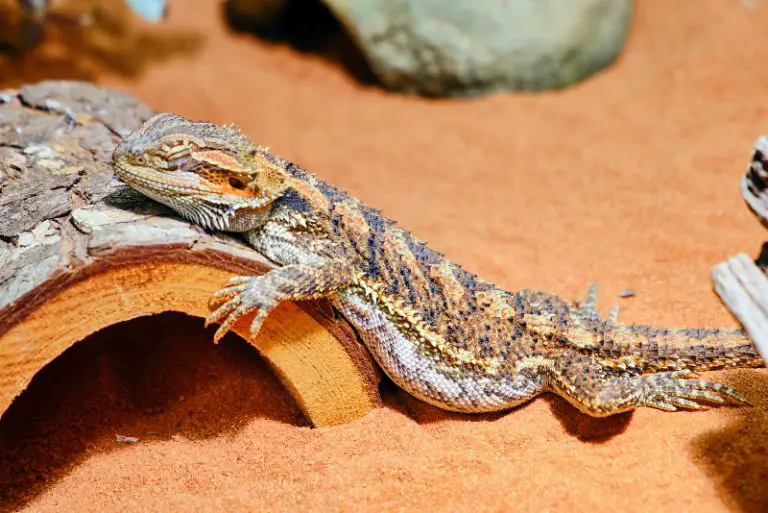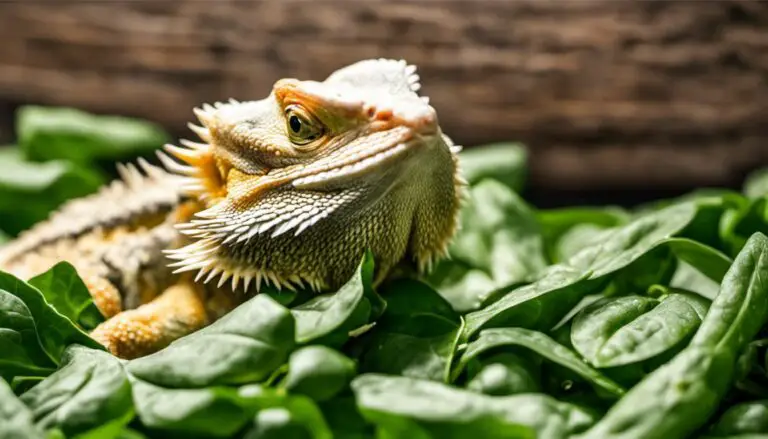How to Bathe a Bearded Dragon: Essential Tips and Tricks

Is your bearded dragon in need of a good bath? Discover the ultimate guide on “How to Bathe a Bearded Dragon.” From setting up a safe bathing environment to gentle techniques for keeping your reptile clean, we’ve got you covered. Get ready to pamper your scaly companion and ensure their hygiene and well-being with our expert tips and advice.

Contents
Table of Contents
How to Bathe a Bearded Dragon: Ultimate Guide
Bearded dragons are fascinating and relatively low-maintenance pets, but owners should be aware of the importance of proper hygiene for their scaly friends. One essential aspect of maintaining a healthy bearded dragon is regularly providing them with baths.
Not only do these baths aid in their cleanliness, but they also contribute to proper hydration, help in shedding, and provide an opportunity for owners to closely observe their pet’s overall health.
Bathing a bearded dragon might seem intimidating at first, but with the right knowledge and tools, the process can become a stress-free and enriching experience for both the owner and the reptile.

In this article, we will guide you through the necessary steps to ensure a safe and enjoyable bath for your bearded dragon, as well as discuss the optimal frequency of bathing and addressing any potential concerns that may arise during the process.
Why Bathe a Bearded Dragon
Bathing a bearded dragon offers multiple benefits to their health and wellbeing. One of the primary reasons is to maintain proper hygiene by removing old skin and built-up debris on their claws and feet. Regular baths can improve a bearded dragon’s overall cleanliness and help prevent potential infections or illnesses.
Hydration is another important aspect of your bearded dragon’s health. As these reptiles are native to arid environments, ample hydration helps them function optimally. Baths can contribute to keeping your bearded dragon well-hydrated, allowing them to absorb some water through their skin and vent areas.
Shedding is a natural part of a bearded dragon’s life, and regular baths can ease this process. When beardies shed, they can experience mild discomfort, and a bath can help to provide relief by moistening their skin and facilitating the removal of loose skin. This promotes skin health and prevents any potential issues related to improper shedding.
Lastly, bathing your bearded dragon can have a positive impact on their digestive health. Although not a guarantee, baths can sometimes promote bowel movements in beardies, relieving mild constipation and ensuring their overall digestive wellness.
In summary, bathing a bearded dragon is essential for maintaining their overall health, hygiene, hydration, shedding process, skin health, and digestive health. By providing your pet beardie with regular baths, you contribute to their wellbeing and longevity.
Preparing the Bath

To begin bathing your bearded dragon, it is crucial to prepare a suitable bathing environment. Start by selecting an appropriate container, such as a tub or basin, for your bearded dragon to comfortably fit inside. Ensure the container has enough depth to allow your pet to be partially submerged but shallow enough to prevent drowning.
Fill the selected container with lukewarm water, ideally between 85-95°F. It is essential to maintain a warm water temperature as it closely mirrors their basking spot temperature, providing a comfortable experience.
Use a thermometer to accurately measure the water temperature and avoid potential burns or discomfort.
It is recommended to use tap water for your bearded dragon’s bath, as it is generally clean and suitable for both bathing and drinking. Depending on your location, a water dechlorinating substance may be necessary to ensure the water is safe for your pet.
Once the container is filled with the appropriate level of warm water, consider including additional elements to improve the bathing environment. For instance, you can place a climbing rock or a non-slip surface at the bottom of the container for increased safety and ease of movement. This step will allow your bearded dragon to enjoy its bath without feeling stressed or unsafe.
In summary, to prepare a bearded dragon’s bath, you will need:
- A suitable container, such as a tub or basin
- Warm water, with a temperature between 85-95°F, monitored with a thermometer
- Tap water, possibly treated with a water dechlorinating substance
- Optional: a climbing rock or non-slip surface for added safety
Bathing Process and Techniques
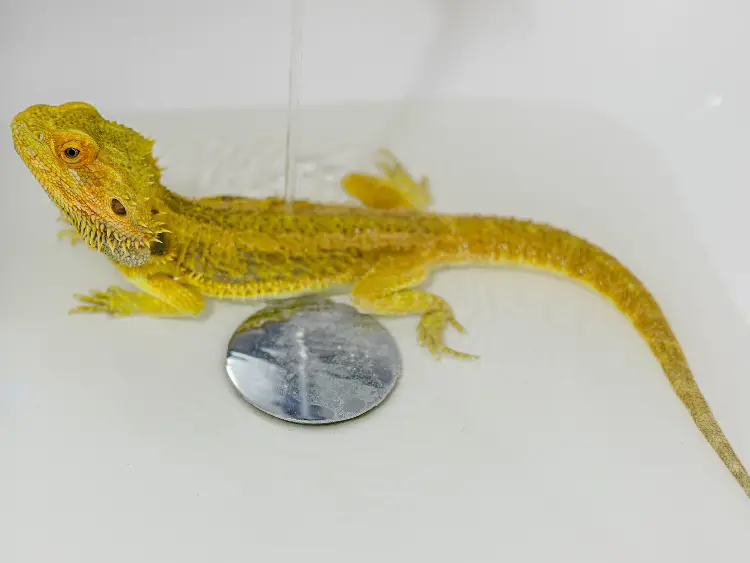
Water Level and Temperature
When bathing a bearded dragon, it’s crucial to maintain the proper water level and temperature. Typically, the water should be 85 to 100 degrees Fahrenheit and only deep enough to reach your bearded dragon’s shoulders, allowing them to easily move and float.
Use a thermometer to ensure the water stays within this range. If the water becomes too cold, you can add more warm water to maintain the ideal temperature.
Safety Precautions
Safety is key when bathing your bearded dragon. Ensure that the tub or large container you use is free from any potential hazards, such as slippery surfaces, sharp edges, or toxic materials. Also, make sure your bearded dragon isn’t left unattended in the bath, as there is a risk of drowning if they are unable to keep their head above water.
Remember to gently handle your bearded dragon when placing them in and out of the bath, and give them time to get comfortable with their surroundings.
Cleaning Techniques
Bathing a bearded dragon involves more than just placing them in the water. To clean them effectively, follow these steps:
- Start by gently pouring or misting water over your bearded dragon’s body. Avoid getting water in their eyes and nostrils, as this can be harmful.
- If there’s any visible dirt or debris on their skin, use a soft toothbrush or cloth to gently brush or wipe it away. Be extra careful around the face and eyes.
- When cleaning the scales, do not use soap or chemicals, as these can harm your bearded dragon’s skin. Instead, stick to plain water or an organic aloe vera mixture to assist with hydration and skin care.
- Once your bearded dragon is sufficiently clean, gently remove them from the bath and pat them dry with a towel. Ensure all areas, including underneath their body, are dry before returning them to their enclosure.
By following these guidelines, you can provide your bearded dragon with a safe and comfortable bathing experience, keeping them both clean and healthy.
How To Give A Bearded Dragon A Bath The Right Way !!! Tips And Tricks
Post-Bath Care and Hygiene
Drying Your Bearded Dragon
After bathing your bearded dragon, it is important to dry them off to maintain their health and comfort properly. Remove your dragon from the water and place them on a soft, clean towel. Gently pat them dry, taking care not to rub their skin, as this can cause irritation. Make sure to have a special towel just for your dragon.
Once your bearded dragon is dry, it is crucial to get them under their basking light to warm up. Their temperature may have dropped during the bath, so warming them up under the basking light is essential.
Cleaning the Habitat
A clean habitat is vital in maintaining your bearded dragon’s health and happiness. Regular cleaning of the terrarium will prevent the buildup of harmful bacteria and ensure a healthy environment for your pet.
- Remove the bearded dragon and any decorations from the terrarium.
- Dispose of the old substrate and replace it with fresh, clean substrate.
- Clean the terrarium’s surfaces with a mix of white vinegar and water, ensuring all areas are thoroughly cleaned.
- Wipe down the surfaces with paper towels, removing any residue from the cleaning solution.
- Dry the terrarium completely to prevent excess humidity.
- Place the decorations back into the terrarium, and return your bearded dragon to their basking spot.
By following these steps, you can ensure a clean and healthy habitat for your bearded dragon, and help them maintain proper hygiene after their bath.
Bathing Different Ages and Sizes

Bathing Baby Bearded Dragons
Baby bearded dragons require frequent bathing to aid in shedding and maintain proper hygiene. You can bathe them every 2-3 days, using a shallow container with only about 0.5 inches of water.
Make sure to use warm water and gently place the baby bearded dragon in the water. Allow them to get comfortable, and clean them if necessary.
Bathing Juvenile Bearded Dragons
Juvenile bearded dragons should be bathed every 3-4 days. When preparing the bath, fill the container with about 1 inch of warm water.
As with baby bearded dragons, gently place your juvenile bearded dragon into the water and let them acclimate to the temperature. You may want to use a climbing rock in the container for added comfort and safety.
Bathing Adult Bearded Dragons
Adult bearded dragons require less frequent baths, usually once a week to ensure proper shedding and hydration. For adults, prepare a bath with up to three inches of warm water, depending on their size. Gently place the adult bearded dragon in the bath and allow them to get comfortable.
You may also use a climbing rock for safety and comfort during the bathing process.
Addressing Health Issues with Baths
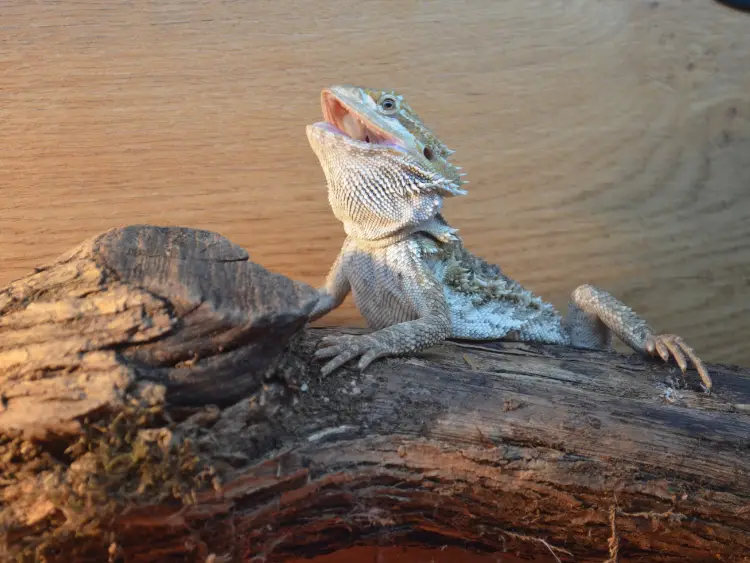
Aiding Shedding Process
Bathing a bearded dragon can be beneficial for their health, particularly during the shedding process. When bearded dragons shed their old skin, baths can help soften the skin and make it easier for them to remove it. The warm water helps to moisten the old skin, allowing it to come off more effortlessly.
You can gently rub your bearded dragon during the bath, to further help release the old skin. Make sure to be gentle and avoid pulling on any loose skin, as this can be harmful. Regular baths during shedding can effectively prevent any stuck shed from causing issues for your pet.
Relieving Constipation and Impaction
Constipation and impaction are common health issues in bearded dragons, usually resulting from a poor diet or ingestion of indigestible objects.
Baths can aid in relieving these issues by promoting bowel movements in your pet. The warm water encourages relaxation and softens feces, making it easier for the bearded dragon to pass them.
During the bath, you can also gently massage your bearded dragon’s belly, which can help stimulate bowel movements. Ensure that the water temperature is within the appropriate range of 85-95°F for the bearded dragon’s comfort and safety. Keep an eye on your pet while they are in the bath, and be prepared to remove them promptly if they show signs of distress.
Preventing Infections
Baths can play a role in maintaining your bearded dragon’s overall hygiene, as they help clean dirt and debris from their skin. Additionally, a clean environment is essential in preventing bacterial and fungal infections that can be detrimental to their health.
Make it a habit to regularly clean their enclosure and always use clean, dechlorinated water for baths to ensure optimal hygiene.
In summary, baths can be beneficial in addressing health issues in bearded dragons, such as aiding shedding, relieving constipation and impaction, and preventing infections. Practicing proper bathing techniques and hygiene measures can greatly contribute to your pet’s general well-being.
Preventing Infections and Parasites

Regular baths play a crucial role in maintaining your bearded dragon’s health, as they aid in preventing infections and parasites. Taking proper care of your bearded dragon and ensuring their living conditions remain clean will significantly reduce the risk of bacteria, fungus, and parasites.
When bathing your bearded dragon, it’s essential to use warm water, and avoid using soap or other harsh chemicals that can potentially harm your pet. Instead, you can use a mild reptile-safe shampoo or even offer them a bath with a teaspoon of Epsom salt, which can help kill off parasites and alleviate skin irritation.
Make sure to clean and disinfect their enclosure regularly to inhibit the growth of harmful microorganisms. This includes removing waste, uneaten food, and shedding skin, as well as thoroughly sanitizing their living space with pet-safe cleaning solutions. You should also:
- Replace the substrate frequently
- Clean feeding and water dishes daily
- Disinfect decorations and hides on a regular basis
Monitoring your bearded dragon closely and being mindful of any changes in their behavior or appearance can also help detect issues early on. If you suspect your pet may have a bacterial or fungal infection or internal parasites, take them to a veterinarian for proper diagnosis and treatment.
Lastly, be aware that bearded dragons can carry salmonella, so it’s important to practice good hygiene, wash your hands thoroughly after handling your pet or cleaning their enclosure, and avoid exposing young children, elderly people, or those with weakened immune systems to your bearded dragon. By taking these measures, your pet will stay healthy and you can prevent infections and parasites.
Additional Tips and Recommendations
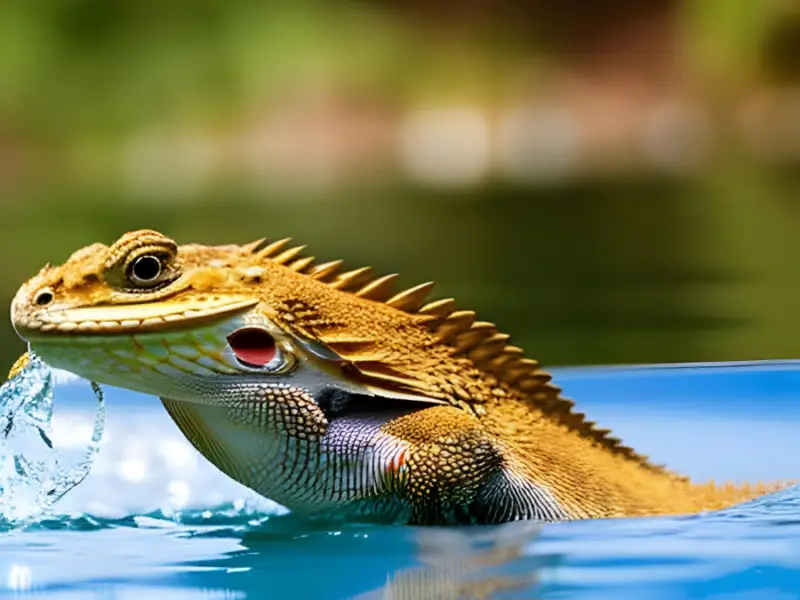
When bathing your bearded dragon, maintaining cleanliness is essential. If your reptile happens to defecate during the bath, remove the poop immediately and consider changing the water. This helps to prevent any contamination or spread of bacteria.
To avoid a dehydrated bearded dragon, ensure the water is not too hot. Keep the water temperature between 85 and 100 degrees, as this range aids in comfortable bathing and supports their body temperature regulation. Monitor the temperature with a thermometer and adjust accordingly.
One recommendation for bath time is to provide a comfortable and safe environment. You may use plastic storage bins as an alternative to bathtubs, and adding toys or non-slip material to the bath can make your lizard feel more secure. Avoid using loose substrate that could cause injury to their feet or affect their health.
During the bath, you can take the opportunity to check for any health concerns. Use a soft-bristled toothbrush to gently brush your bearded dragon, paying attention to their feet, tail, and cloaca. This gentle brushing not only aids in proper hygiene but also promotes bonding between you and your bearded dragon.
Speaking of bonding, adult bearded dragons can benefit from regular baths once per week. Bath time facilitates play, relaxation, and promotes a trusting relationship. However, always provide supervision to ensure their safety during the bath.
Bathing your bearded dragon also provides health benefits, such as improved digestion and alleviating shedding issues. During shedding periods, consider increasing the bathing frequency to 3-4 times per week, which eases the old skin off.
Lastly, remember that your bearded dragon’s welfare should be your top priority. Observe their behavior during the bath, and adjust the experience to meet their individual needs and preferences. By doing so, bathing will become an enjoyable and beneficial experience for both you and your bearded dragon.
FAQs: Bathing Your Bearded Dragon – Everything You Need to Know
How often should I bathe my bearded dragon?
Bearded dragons typically require bathing 1-2 times per week.
What is the ideal water temperature for a bearded dragon’s bath?
Ensure the bath water is warm, but not hot, to keep your dragon comfortable.
Can I use a soft towel to dry my bearded dragon?
Yes, gently pat your dragon’s body with a soft towel to remove excess moisture.
How do I safely bathe my bearded dragon?
Handle your bearded dragon properly, supporting their body, and use lukewarm water.
Can bearded dragons drink water during their bath?
Yes, some bearded dragons may drink water during bath time if they choose to.
How do I clean the old skin from my bearded dragon?
Gently rub the dragon’s skin with a soft toothbrush to help remove old skin.
Is it important to monitor the water temperature during bathing?
Yes, maintaining a suitable water temperature is crucial for your dragon’s health.
Should I provide a basking light during bath time?
No, a basking light is not necessary during bathing; it’s for providing heat in their enclosure.
How can regular baths benefit my bearded dragon?
Regular bathing helps keep their skin clean, hydrates them, and promotes good health.
Can I use tap water for my bearded dragon’s bath?
Yes, tap water is safe as long as it is free from harmful chemicals and contaminants.
In conclusion, bathing your bearded dragon at the right temperature and frequency, using gentle techniques, promotes cleanliness, hydration, and overall well-being for your beloved pet lizard.

